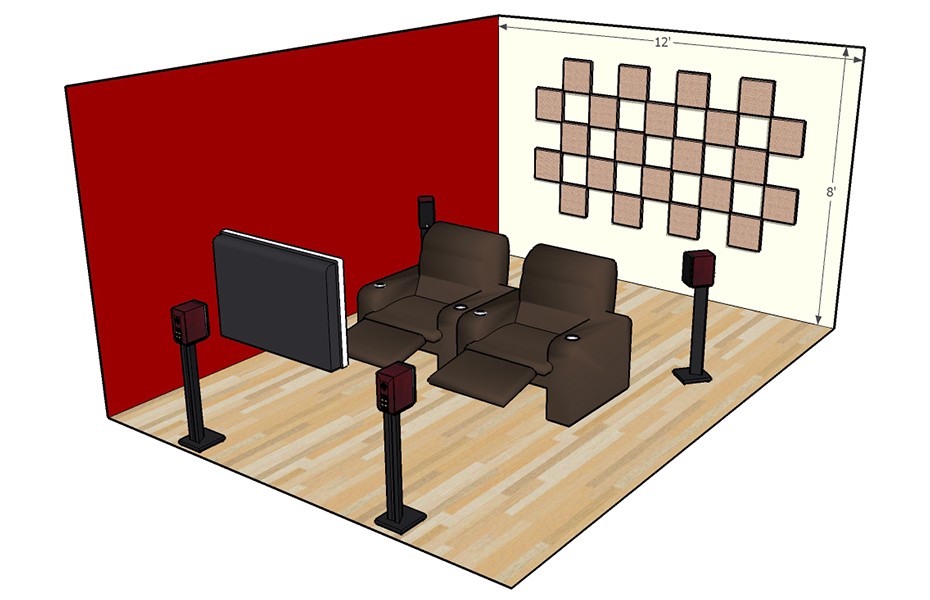
Acoustic Treatment and Sound Isolation
Acoustic Treatment and Sound Isolation is really important when it comes to home cinema and HiFi.
It not only stops you from annoying the neighbors, but it can improve the dynamics of the audio and early reflections from sound wave. People’s living spaces, listening rooms are all different in sizes, heights, with curtains and furniture all affecting the soundwaves in different ways. This article will explain in what the terms are when it comes acoustic treatment and give recommendations to counteract issues that arise.

Factors that influence acoustic quality of a room:
- Furniture and furnishings
- Material of the room walls and floor
- Position of the listening area
- Shape of the room
- Speaker placement
Soft furniture and curtains can soak up a lot of sound, and is good for sound insulation. It stops sound waves bouncing around the room. That is why empty rooms and bathrooms sound echoey. The larger the room the further sound waves have to travel. With larger spaces it is hard to fill the space with furnishings, which also increases the echo/bounce factor.
Hard materials like wooden or concrete floors, and concrete or glass walls increase sound wave reflection. Carpet, rugs, curtains and wallpaper can reduce harsh reflections.
Room Modes
Room modes are resonances that exist in a room when a room is exposed to a sound from a loudspeaker.
Based on the room size and shape, sound waves have different lengths and bounce off the wall and reflect back in the opposite direction. This will make some frequencies much louder in different areas of the room. Music mixed, produced and mastered in an untreated room can sound very different to it’s final product. This is the main reason you see many acoustic panels, dampeners and bass traps in recording studios. They stop the sound waves from reflecting and help with sound proofing inside the “live room”. When in the “control room” acoustic treatments are used so the mixers hear an accurate representation of the recording during the mixing stages.
“Most rooms have their fundamental resonances in the 20 Hz to 200 Hz region, each frequency being related to one or more of the room’s dimensions or a divisor thereof. These resonances affect the low-frequency low-mid-frequency response of a sound system in the room and are one of the biggest obstacles to accurate sound reproduction.”
Early Reflections
Very much related to the previous topic. Early reflection occurs in small spaces. From the loudspeaker the sound hits your ears, then these signals continue travelling and bounce off the walls, ceiling and floors and arrive at your ears again.
This introduces time delay that mixes in with the signal/soundwave. You can reduce the effects of early reflection and room modes by using acoustic panels. They can be installed at the point of reflection in relation to the listening position. The way you can find the point refection is to use a mirror. Sit in your listening position and place the mirror at the point in with you can see the tweeter of the loudspeakers. That is the point in which you can mount a panel on the wall. Columns like the Primacoustics are great and can complement the architecture of your listening space.
Trap the Bass
In a small room low frequencies can be a challenge. This is because bass frequencies are longer (in soundwave length) and they are more powerful than treble frequencies. Since bass waves are longer they can bounce off several walls creating spots in the room where you cannot hear the bass. Including bass traps in the corners of the room is a good way to start tackling this challenge. Primacoustic Australis Bass Trap

Absorbing vs Diffusing
There difference between absorbing and diffusing early reflections.
Absorbing traps the sound, it tries to soak up the first reflection and eliminate any “bounce”. When you diffuse, you scatter the sound so that the wave doesn’t bounce directly back to the listening position. Rough surfaces (curtains, wallpaper) disperse audio better. Hard smooth surfaces (like glass and concrete) encourage echos and reflections. A virtually zero-cost solution is to use egg cartons to help defuse the soundwaves at the points of reflection, you can stick them on the ceiling or walls. Trapping the sound is usually better than diffusing. Diffusion scatters the wave which makes it less intense and therefore less likely to interfere with the original signal. It is still an effective solution if trapping is not an option.
Recommendations
Here are our quick tips on where to start if you want to start acoustically treating your room.
- Bass traps on the back wall or corners of the room: The Primacoustic London Bass Trap consists of two 24” x 48” panels that effectively absorb sound energy down to 100Hz. Comes with all the corner brackets anchors and screws you may need.
- Install acoustic dampeners on the ceiling above the listening position. Something like the Primacoustic Broadway Scatter Blocks are a great option.
- Install acoustic panels on the left and right wall at the points of first reflection (using the mirror technique). Primacoustics Broadway Control Columns
- Isolate the Subwoofer. Using the SVS subwoofer isolation system decouples and isolates the sub from the floor. It actually works with any brand of subwoofer. It will give you less rattle from nearby objects, and won’t annoy the other occupants in the home.


Contact us for availability of any acoustic panel kits, or if you want any advice about acoustic treatment. We are more than happy to have a chat. (09 274 4515, [email protected])
- Projector Lamp Longevity
- What is HDBaseT?
- Subwoofers: The Guts and the Glory
- The Art of Subwoofer Placement
- The Cabinet & the Subwoofer
- Do projection screens really differ?
- HDMI Audio Return Channel (ARC)
- HDMI Matrix Switchers
- HDMI over Cat 5/6 Extender’s
Sources: Rapallo Ltd, Cnet, SVS, Primacoustic







